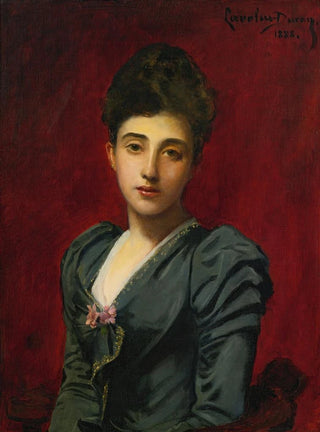Art print | Portrait of the Countess Lily De Roussy De Sales - Carolus-Duran


View from behind

Frame (optional)
Portrait of the Countess Lily De Roussy De Sales - Carolus-Duran – Captivating Introduction
In the vast universe of painting, some works manage to transcend the simple frame of art to become witnesses of an era, reflections of society. "Portrait of the Countess Lily De Roussy De Sales" by Carolus-Duran is one of these creations. This painting, created at the end of the 19th century, captures not only the beauty of its subject but also the spirit of a time when nobility and elegance blended with modernity. Contemplating this portrait, the viewer is immediately transported to a world where every detail, every brushstroke, tells a story. The Countess Lily de Roussy de Sales, an iconic figure of French high society, is depicted here with a delicacy and depth that invite reflection.
Style and uniqueness of the work
Carolus-Duran's style is distinguished by its realistic approach and its ability to capture light and textures. In this portrait, the Countess's dress, richly adorned and delicately draped, seems almost alive, as if it could move under the admiring gaze of the viewer. The color palette chosen by the artist, oscillating between warm tones and cooler shades, creates a striking contrast that highlights the serene face of the Countess. The eyes, a deep blue, seem to pierce the painting, establishing an intimate connection with those who dare to delve into it. This art print goes beyond simple representation; it is a celebration of femininity and grace, while evoking a certain melancholy, as if the Countess herself bore the weight of her social expectations.
The artist and his influence
Carolus-Duran, whose real name is Charles Émile Duran, is a prominent figure of the Impressionist movement, although he managed to forge his own style, combining realism and Impressionist touches. Born in 1837, he established himself on the French artistic scene thanks to his innovative technique and his ability to capture the essence of his models. Duran also played a crucial role as a teacher, influencing a generation of artists, including

Matte finish

View from behind

Frame (optional)
Portrait of the Countess Lily De Roussy De Sales - Carolus-Duran – Captivating Introduction
In the vast universe of painting, some works manage to transcend the simple frame of art to become witnesses of an era, reflections of society. "Portrait of the Countess Lily De Roussy De Sales" by Carolus-Duran is one of these creations. This painting, created at the end of the 19th century, captures not only the beauty of its subject but also the spirit of a time when nobility and elegance blended with modernity. Contemplating this portrait, the viewer is immediately transported to a world where every detail, every brushstroke, tells a story. The Countess Lily de Roussy de Sales, an iconic figure of French high society, is depicted here with a delicacy and depth that invite reflection.
Style and uniqueness of the work
Carolus-Duran's style is distinguished by its realistic approach and its ability to capture light and textures. In this portrait, the Countess's dress, richly adorned and delicately draped, seems almost alive, as if it could move under the admiring gaze of the viewer. The color palette chosen by the artist, oscillating between warm tones and cooler shades, creates a striking contrast that highlights the serene face of the Countess. The eyes, a deep blue, seem to pierce the painting, establishing an intimate connection with those who dare to delve into it. This art print goes beyond simple representation; it is a celebration of femininity and grace, while evoking a certain melancholy, as if the Countess herself bore the weight of her social expectations.
The artist and his influence
Carolus-Duran, whose real name is Charles Émile Duran, is a prominent figure of the Impressionist movement, although he managed to forge his own style, combining realism and Impressionist touches. Born in 1837, he established himself on the French artistic scene thanks to his innovative technique and his ability to capture the essence of his models. Duran also played a crucial role as a teacher, influencing a generation of artists, including






